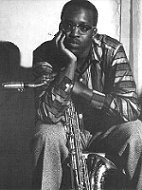 |
Hank MobleyTenor Saxophone |
|---|
 |
Hank MobleyTenor Saxophone |
|---|
"Hank Mobley is the most lyrical saxophonist I've ever heard. He sang into his horn"
--Benny Golson
Hank Mobley was born on July 7, 1930 in Eastman, Georgia, and raised in Elizabeth, New Jersey. There was much music in his family, particularly piano music. Uncle Dave Mobley played piano among other instruments, and his mother and grandmother also played keyboards (his grandmother was a church organist). Piano became Mobley's first instrument; then he picked up the tenor sax at age 16 and basically taught himself the horn. On his uncle's advice, he listened initially to Lester Young and then to Don Byas, Dexter Gordon and Sonny Stitt. "Anyone who can swing and get a message across," as Mobley explained his influences to Leonard Feather in 1956.
By his late teens, Mobley was working as a professional musician. He was hired by Paul Gayten and worked the rhythm and blues circuit with him between 1949 and '51, having been recommended by Clifford Brown (who had not heard Mobley play at the time but was aware of his growing reputation). "Hank was beautiful, he played alto, tenor and baritone and did a lot of the writing," Gayten recalled. "He took care of business and I could leave things up to him."
The Gayten band also included baritone saxophonist Cecil Payne and future Ellingtonians Clark Terry, Aaron Bell and Sam Woodyard. Working with the last three no doubt eased the way for Mobley's two-week stint as Jimmy Hamilton's replacement in the Ellington Orchestra during 1953. ("I didn't play clarinet, but I played some of the clarinet parts on tenor," he later recalled). While the band recorded, the material did not feature Mobley as a soloist.
Mobley's jazz recording debut was the product of a job he held in the house band of a Newark nightclub after leaving Gayten in 1951. Another promising youngster and future Blue Note artist, pianist Walter Davis, Jr., was also a part of the group, and the opportunity to back visiting stars including Miles Davis, Dexter Gordon, Billie Holiday, Bud Powell and Lester Young was invaluable to their rapid development.
Max Roach hired both Mobley and Davis after appearing at the Newark club, and brought them into rooms like the Apollo Bar before recording with them for Debut in March 1953. The session (now available on OJC) included both quartet and septet tracks and captures an already recognizable tenor stylist and composer. Roach reportedly tried to summon both Mobley and Clifford Brown to California to form what would become the Brown/Roach quintet in the summer of 1953, but was only able to locate the trumpeter.
Back on the East Coast, Mobley gained further experience with Davis, Tadd Dameron, Milt Jackson and J.J. Johnson. For much of 1954 he worked with Dizzy Gillespie, and participated in four of the trumpeter's recording sessions. After leaving Gillespie in September 1954, Mobley joined pianist Horace Silver's quartet at Minton's Playhouse, a group completed by basist Doug Watkins and drummer Arthur Edgehill.
"On weekends Art Blakey and Kenny Dorham would come in to jam, 'cause they were right around the corner," Mobley recalled, which led to Silver's first quintet session for Blue Note with Dorham, Mobley, Watkins and Blakey. The session was issued as Horace Silver and the Jazz Messengers, working a variation on the Messengers name that Blakey had employed for a larger ensemble several years earlier; and the five musicians decided to work in a cooperative relationship whenever any one of them was offered work.
When it came to music, Hank Mobley was extremely sure-footed in this period. If his drug problem created a less steady personal life and slowed his recording activities significantly for much of 1958 and '59, he was able to bounce back with Blue Note in 1960, when he entered his truly golden age on albums like Soul Station, Roll Call, and Workout.
Possessed of both his own conception, which made his music readily identifiable, and the equally rare inspiration that also made listening to his work eminently satisfying, Mobley was perpetually eclipsed throughout his career by more extroverted and influential sylists. His work was often downgraded as a lesser version of Sonny Rollins; and in 1960 and '61, when he worked with Miles Davis and recorded what are his greatest sessions under his own name, he was dismissed for not measuring up to his predecessor in the Davis band, John Coltrane.
When the avant-garde innovators dominated the attention of jazz critics a few years later, Mobley's playing was often dismissed as old hat and irrelevant. It has only been in the years since he stopped recording (his last session, co-led with Cedar Walton, took place in 1972), and especially since his death in 1986, that the exceptional quality of his playing and writing has begun to receive a commensurate measure of respect.
--BOB BLUMENTHAL, from the liner notes,
The Complete Blue Note Hank Mobley
Fifties Sessions, Mosaic.
A selected discography of Hank Mobley albums.
| Find Hank Mobley on Amazon.com | Find Hank Mobley on eBay.com | |
|---|---|---|
| Hank Mobley CDs on Amazon | Hank Mobley CDs on eBay | |
| Hank Mobley Tenor Solos, BOOK | Hank Mobley LPs on eBay | |
| Hank Mobley DVD / VHS on eBay | ||
| Hank Mobley BOOKs on eBay |
 Music |
 Home |
 Musicians |
|---|
|
Any comments, additions or suggestions should be adressed to:
The Hard Bop Homepage / Eric B. Olsen / ebolsen@juno.com |
Other Web Sites:
The Film Noir 'net A History of Horror The War Film Web Author Eric B. Olsen |